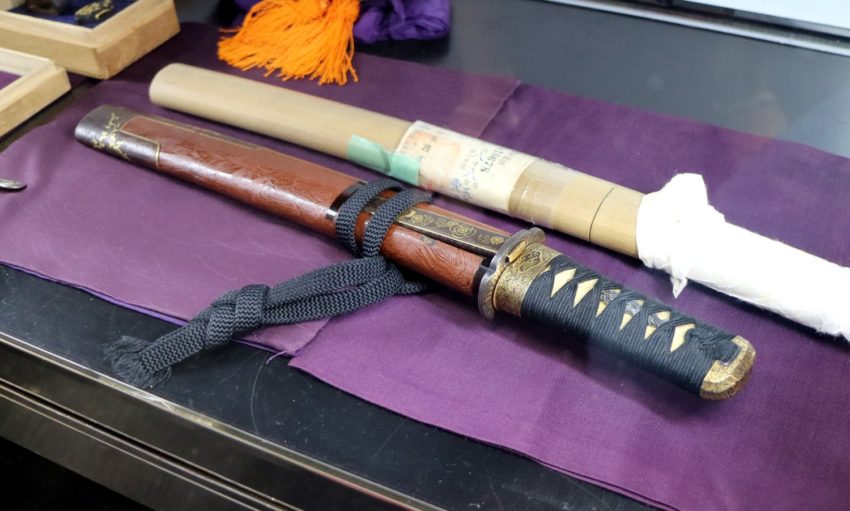Now, we don’t know about you for sure, but when we hear the phrase “traditional Japanese swords,” we think of the katana. And while katanas are most certainly sterling examples of traditional Japanese swords, there are other blades that are just as closely associated with the land and culture of “Glorious Nippon.”
This article intends to highlight these blades, their role within Japanese history, how they have become synonymous with the nation of Japan. We’ll even address how such blades have managed to stay popular centuries after they were heavily regulated, if not outright destroyed, by the Japanese government.
The Different Types of Traditional Japanese Swords
There are four major types of Japanese sword that you’ll read about in this section: the tanto, the wakizashi, the tachi, and the katana.
Traditional Tanto Swords: Straight Edges
The tanto can be traced as far back as Japan’s Heian Period of 794 to 1185. The key lethal aspect of the tanto, its blade, is that it has a straight edge. It could be either single- or double-edged. Tantos ranged in length from 5.9 to 11.8 inches.
The weapon’s name is literally translated as “short sword.” Tantos were mostly carried by samuraiSAMURAI 侍 "warrior serving a lord" learn more..., though similar small blades, called kaiken, might be carried by their wives for use as a self-defense tool. Before the wakizashi came along (see the next section), the tanto was a common complementary short blade for those who carried a long tachi sword.
The Shorter Wakizashi
The wakizashi is sort of the middle child among three specific weapons, having a blade length anywhere from 12 to 24 inches. As there is a specific measuring system when it comes to things like blade length, some wakizashi are referred to with an “o-” or a “ko-” in front, signifying that they are exceptionally long or short, respectively.
Any man who publicly carried a wakizashi and katana combination was a man who was declaring that he was a samurai. This weapon’s name translates as “side-inserted sword” and although it might be thought of as a “junior katana,” wakizashi were actually made with a different design and crossguard.
Long and Curved Tachi Blades
Put simply, the tachi is the katana’s father – hey, you can have “bastard swords,” why not father swords? Anyway, the tachi is the predecessor to the katana and was the common side sword for samurai from 900 all the way up to the first half of the 1500s. Tachi were worn with their tips pointing downward, instead of upward like the katana. These weapons were lighter, more tapered, and curved more with a smaller point than katanas.
The Classic Katana
While Japan has evidence of swords going as far back as 900, the first instances of katana specifically being in the country were during the Kamakura Period that began in 1185 and ended in the year 1333. The armor of raiding Mongols during the 14th century required an evolution in Japanese weapons. The commonly understood aesthetics of a katana grew quite prominent from 1337 to 1573, a time known as the Muromachi Period.
How Traditional Japanese Swords are Part of Japanese Culture
While Japan has many cultural symbols, like the tea ceremony, kimono, bonsai, Mt. Fuji, et cetera, the actual name for bladed weapons, nihontoNIHONTO 日本刀 "Japanese sword" learn more..., contains the country’s name. As to why blades are so closely associated with Japanese culture, a good chunk of it has to do with the famed samurai.
A katana was sort of the status symbol of a samurai, especially when paired with a wakizashi. Even when the samurai were phased out through the advances of military tactics and firearms, many members of Japan’s armed forces sought to preserve their ancestors’ contributions to Japan. They incorporated those samurais’ blades into their officer swords.
There is also something to be said for the fact that at least one or two of the three types of blades we have previously discussed were commonly used during the ritual exercise of seppukuSEPPUKU 切腹 "cutting the stomach" learn more.... While the atoning samurai would use a short blade to slice open his belly, an appointed second person – often a close friend or even a respected opponent – would then use a katana to nearly decapitate the dying samurai. (Full decapitation was considered a shameful act for both the samurai and the second; the goal was to leave the samurai’s head resting in his own hands, remaining attached by a thin sliver of neck flesh.)
It should also be mentioned that at least one sword is regarded as part of the Imperial Regalia of Japan. That blade, known as “Murakumo,” belongs to a special group of five Japanese swords known to possess exceptional quality. These “Five Best Swords Under Heaven” remain protected in various locations. They are housed either within museums as they have been designated National Treasures of the country of Japan, a shrine, or a Buddhist temple. It should also be mentioned that only one of these five blades, “Dojigiri,” would be considered a katana.
When you consider how the Japanese admiration for the past, and factor in the many generations that have espoused an adherence to familial loyalty, it makes sense that these classic blades continue to enjoy a position as cultural touchstones.
How Japanese Swords Have Survived Into the Present Day
- While the Japanese government banned the production of swords, and even the teaching of martial arts, for several years after their defeat in World War II, it eventually changed its stance. These days, it is technically possible to purchase legitimate traditional Japanese swords, but there are rules. The weapon must be registered with the Japanese government upon completion and must be made by someone who has apprenticed for at least five years. No single certified swordsmith can forge more than two long swords per year. All that being said, these weapons may resemble the traditional Japanese swords we all admire, but the materials used are far more modern than what was used by smiths half a millennium ago.
- One of the few ways in which the Japanese government did not ban weapons was in the use of historical reenactments. While in-person presentations were perfectly valid exercises to display these blades, it should also be noted that period dramas focusing on the lives and actions of various men and women during the Sengoku Jidai are quite common on Japanese daytime television. Those dramas need things to at least appear authentic.
Analyzing Traditional Japanese Swords Outside of Japan
To take a step outside the country of Japan itself and look at the wider world’s perception of these blades, you have quite a lot of things to consider.
- The term tanto gained a new significance in the 1980s as it was used to signify a tactical dagger designed for stabbing and thrusting. Quite a few American companies were involved in marketing this type of modern blade.
- Films like the Blade and Matrix trilogies did much to cement the notion of a trenchcoat-and-sunglasses-clad character known for carrying a katana (among many other weapons) in video games. This becomes especially familiar – even obnoxiously so – to anyone who played tabletop games set in the modern era of the 1990s and 2000s like Vampire: The Masquerade.
- As previously mentioned, several culturally valuable weapons hang within museums in Japan so that they may continue to enjoy prestige in relative safety. Among those weapons is one forged by the legendary Masamune. We mention this here because another katana forged by Masamune resides within the Harry S. Truman Presidential Library and Museum. Wondering how a Japanese weapon, forged by a man who was arguably the finest Japanese swordsmith to ever live, would make it to America? Well, remember how World War II ended for Japan. This weapon was handed over to Truman by Emperor Hirohito as a symbolic gesture of Japan’s submission to America’s triumph.
- Anime and video games, especially ones that take place within a fantasy world, are full of tropes where at least one character will focus on weapons that would be considered traditional Japanese blades. While you would obviously run into this sort of thing in Japanese-made media, even some Western productions are known to do this. Not that it’s necessarily a bad thing; if anything it only further proves how fascinating this particular subject happens to be. That being said, few impressionable minds did not become fascinated when Sephiroth, Final Fantasy 7‘s main villain, revealed his inhumanly-long “Masamune” uchigatana in battle. While some were distracted by pondering how he could wield such a wrist-breaking blade, the coolness evoked by this weapon and by the man who used it can not be understated.
- Entire television and web videos have popped up with the goal of showcasing the arts of metallurgy and swordsmithing. Many of their videos examine fictional blades, some of which are insanely impractical in reality. Others have been clearly inspired by the designs of traditional Japanese swords and reveal how someone might go about making his own.
Securing Traditional Japanese Swords Today
Buying and collecting (and displaying!) traditional Japanese blades is fun and, thankfully, easier than ever. High-quality reproductions, glistening and sitting proud on their display racks, are available online for affordable prices. Beautiful craftsmanship, striking designs, and gorgeous fittings are as varied as the enthusiasts buying them. Pick your new favorite and if the price is right, go ahead and order it – and enjoy being part of the wonder tradition of Japanese bladed weapons.

